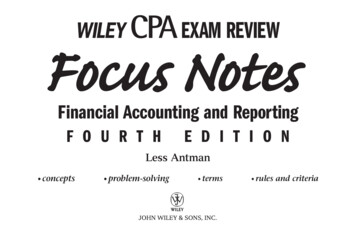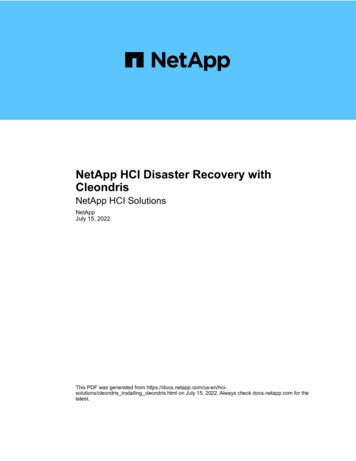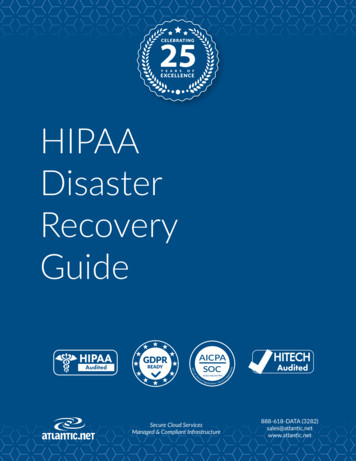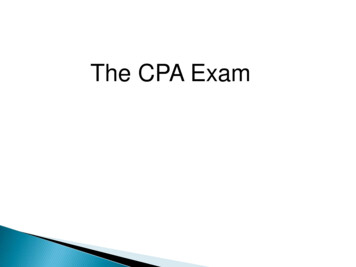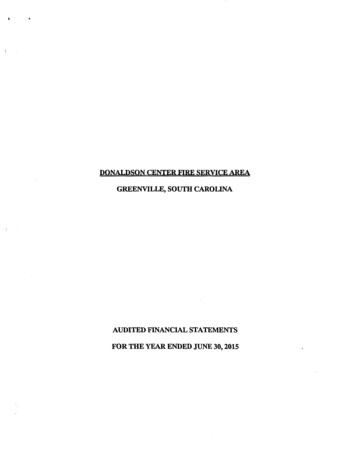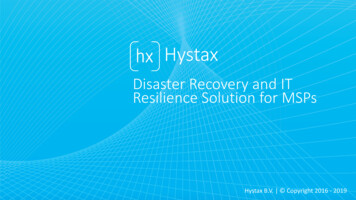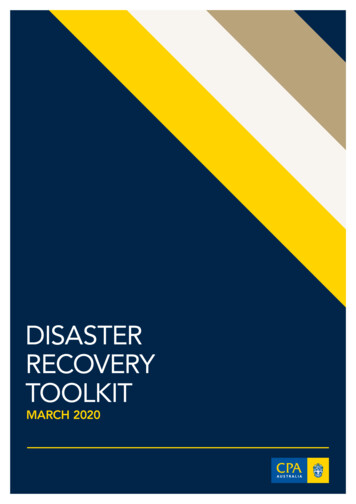
Transcription
DISASTERRECOVERYTOOLKITMARCH 2020
DISASTER RECOVERY TOOLKIT 2CONTENTSINTRODUCTION3WHAT TO DO IMMEDIATELY FOLLOWING A DISASTER4TAKING STOCK OF YOUR BUSINESS - STEPS TO RECOVERY12A POST-DISASTER BUSINESS PLAN24FINANCING YOUR POST-DISASTER BUSINESS30LONG-TERM DISASTER RECOVERY40PREPARING BUSINESS CONTINUITY PLANS42
DISASTER RECOVERY TOOLKIT 3INTRODUCTIONAny business may fall victim to a disaster that may disrupttheir business. The disaster may be an event such as fire,flood or earthquake, a creeping disaster such as droughtor disease, or a disaster that impacts a single business suchas a factory fire or computer virus.Best practice for businesses is to have a continuity plan toassist them respond to such disasters and support recovery.Further information on what your small business can do toprepare for a disaster visit business.gov.au and search for‘when things don’t go to plan'.Unfortunately, experience shows that many businessesdo not have a continuity plan or, if they do, it is inadequate.This makes business recovery more difficult.Following a disaster, it is anything but business as usualfor you, your employees, customers, possibly your suppliersand the broader community.This toolkit is designed to assist small businessesimpacted directly and indirectly by a disaster– especially where they do not have a continuity plan,or their continuity plan proves insufficient. It is intendedto help such businesses take a considered approachto the many elements of recovery following a disaster.This toolkit focuses on business issues we believe thoseaffected by a disaster should consider. It covers:1. What to do immediately following a disaster2. T aking stock – guidance on how to analyse and evaluatethe state of your business3. A new business plan – guidance on developing anew business plan to help recovery and how to fundthat new plan4. Long-term disaster recovery – guidance on additionalactivities that may help your post-disaster businessoperate better than your pre-disaster business.The toolkit includes checklists and templates to assist inthe disaster recovery process.In addition to working through this toolkit, CPA Australiastrongly recommends that you speak to your accountantfor tailored advice following a disaster.This guide does not focus on the myriad of non-businessissues that you may face, including mental health issues.For those issues, we encourage you to seek the supportfrom appropriate professionals and organisations.
DISASTER RECOVERY TOOLKIT 4WHAT TO DO IMMEDIATELYFOLLOWING A DISASTERWITHIN TWO DAYS FOLLOWING A DISASTER1. C ontact all staff and establish their location and whetherthey are safe and well – ask whether they have beenaffected, will they be able to return to work, and if sowhen will they be able to return to work.2. U ndertake an initial damage assessment – If you areallowed to access your premises, develop a list ofdestroyed or damaged items. If possible, estimate theirreplacement costs. Include photos of the damage ifpossible. Do not commence cleaning up until youhave contacted your insurer.3. Contact your insurance company and discuss yourdamage assessment, your level of cover, how quicklyyour claim can be processed, how much and in whatform a claim will be paid and when an insuranceassessor will visit.4. If safe to do so, salvage any remaining equipmentand stock.CHECKLIST – WITHIN TWO DAYS OF A DISASTERAssessment itemStaffHave any of your staff been affected by the disaster?Will they be able to return to work? If so, when?Do you need to put off staff for the time being?PremisesAre your premises operational?Can you recover any of your stock, supplies and/orequipment?Have you created a list of your damaged and undamagedstock, equipment and other assets?Have you taken photographs of the damage includingpremises, equipment, stock etc.?Contact your insurerHave you given your insurer your preliminarydamage assessment?Has your insurer been able to tell you what your insurancepay-out is likely to be, when the pay-out is likely to bemade and whether it will be in the form of cash or assetreplacement or a mix of both?YesNoComments / Notes
DISASTER RECOVERY TOOLKIT 5DAMAGE ASSESSMENT TEMPLATEOverall damage assessment - include a list of destroyed or damaged items, estimatedreplacement costs and include photos if possible. Do not commence cleaning up untilyou have contacted your insurer.Items destroyedEstimated replacement costInsured? Y N Y N Y N Y N Y N Y N Y N Y N Y N Y NPhoto ref #
DISASTER RECOVERY TOOLKIT 6Items destroyedEst’ replacement costInsured? Y N Y N Y N Y N Y N Y N Y N Y N Y N Y NPhoto ref #
DISASTER RECOVERY TOOLKIT 7WITHIN THE FIRST WEEK FOLLOWING A DISASTER– COMMENCING YOUR RECOVERY3. Contact your lender and accountant.1. C ommence actions that will assist you reopen yourbusiness when you are ready - Make a list of keyequipment, stock and other activities of the businessthat need to be operational for the business to reopen.If any key equipment and stock has been salvaged,ensure they are stored in a secure location.4. Assess if you can undertake any temporary trading– do you have forward orders that you can complete,or sales that can be made from salvaged stock.5. Access any business information held incloud-based software.2. C ontact key customers and suppliers to advisethat the business has been affected - let them knowthat you will notify them when you are ready to tradeagain and advise them if orders cannot be completed.Work with your customers to devise a strategy to assistthem in continuing to receive the goods or servicesyou usually provide.6. Consider contacting government agenciesthat may be helping affected businesses, suchas the Australian Government’s Disaster Assistdisasterassist.gov.au website.CHECKLIST – INITIAL ACTIONS FOLLOWING A DISASTERAssessment itemHave you prepared an action list of activities requiredto reopen the business?Can you salvage equipment and stock and place insecure storage?Are you keeping staff, key customers, suppliers andlenders informed of what you are doing in responseto the disaster?Have you collected your computer back-ups and othernecessary information from storage or the cloud?Have you informed customers where supply orderscannot be fulfilled at this time and assisted them to fillsuch orders from other suppliers until you will be ableto supply them again?Do you need to postpone purchasing supplies for thetime being?Can you cancel orders that you have made?Contact government agencies that may be helpingaffected businesses.YesNoComments / Notes
DISASTER RECOVERY TOOLKIT 8TEMPLATE – INITIAL STEPS TO RESTART YOUR BUSINESS WHEN YOU ARE READYWhat items, actions or other activities do you need to re-start the business?Equipment or operationalprocedureWill theequipment orstock be replacedBy when willsuch equipmentor stock bereplaced byIf equipment or stock notcovered by insurance,estimated purchase priceand supplier nameIs hirepurchaseor leasingavailableOther actions requiredE.g. Point of sale equipmentYesWithintwo weeksWithin two weeksN/A Speak to other businesses to see if they have a sparecash register you can use until new point of saleequipment is availableE.g. Commercialgrade fridgesNoN/AA 15,000 – XYZCommercial FridgesYes- leasing Speak to neighbouring businesses to see if youcan temporarily access their commercial fridge Find out the options and timeframe for gettinga replacement fridge Speak to your accountant on whether leasingor outright purchase is preferableE.g. Contact major clientto say you are reopeningfor businessN/AN/AN/AN/A I nform client that due to the impact of the disaster,it may take longer than usual to fill orders
DISASTER RECOVERY TOOLKIT 9Equipment or operationalprocedureWill theequipment orstock be replacedBy when willsuch equipmentor stock bereplaced byIf equipment or stock notcovered by insurance,estimated purchase priceand supplier nameIs hirepurchaseor leasingavailablezOther actions required
DISASTER RECOVERY TOOLKIT 10WITHIN THE FIRST MONTH FOLLOWING A DISASTER– FURTHER INITIAL STEPS TO AID RECOVERY1. I f required, look for alternative temporary businesspremises. When assessing this requirement, not onlydoes the premises need to be safe but you need toconsider whether your staff, customers and supplierswill be able to access the alternative premises.2. R eview your business records - collect all businessrecords that have been salvaged, or copies kept off sitethat are retrievable. Where there are gaps in records,consider alternative sources to help you reconstruct yourfinancials. You may like to talk to your accountant at thisstage for assistance.LIST OF POTENTIAL SOURCES OF BUSINESS RECORDSSourcePotential InformationSurviving files / Cloud based / back up dataSee if any files, including electronic files can berecovered, including any back- up data you may have.Taxation Office, State revenue authoritiesYour My Gov account, single touch payroll accounts,prior income tax returns and other tax forms.In Australia, this includes Business Activity Statements,Fringe Benefit Tax returns, PAYG Annual Statements,Employer Declarations, Payroll Tax returns etc.AccountantYour accountant may have copies of financial statementsand tax returns for your business.Banks, credit unions and building societiesPast bank statements are a great resource forreconstructing your records. For example, a businessmay remember or take a good guess at what many of thetransactions on a bank statement were for, even thoughthe primary records of the transactions are gone. Bankscan charge for replacement statements; however, theymay waive such fees following a disaster.Off-site sourcesConsider whether any files are kept off-site, for example,where activities are outsourced e.g. IT, payroll, etc.In such a situation, the service provider may haveinformation on file. If you have cloud data, you may beable to retrieve the data quickly.StaffAsk staff if they have records off-site, e.g. emails,documents on their computer, memory sticks andother electronic storage devices.LendersIf your business has borrowed money from a bank oranother lending institution, they may have financialinformation on file, such as annual financial statements,forecasts and budgets and other information regardingthe loans.
DISASTER RECOVERY TOOLKIT 11SourcePotential InformationCustomers and suppliersCustomers and suppliers may have invoices, remittanceadvices, purchase orders, receipts etc. that theymay share.Corporate regulatorYour financial statements may have been lodged withthe corporate regulator. In Australia, the regulator is theAustralian Securities and Investments Commission.Auditors / back up dataIf your financial statements are audited, your auditorsmay be able to provide copies of work papers andother records obtained during an audit as well as anypolicies or procedures they may have taken copies ofand financial statements.InsurerYour insurer may have a list of the assets owned bythe business.Other government agenciesIf the business has received government funding/grants,the awarding government agency may have records.Accreditation, certification or licensing bodiesIf your business is subject to any other form of certification,licensing or accreditation, those bodies may have recordsthat could be used.
DISASTER RECOVERY TOOLKIT 12TAKING STOCK OF YOURBUSINESS – STEPS TO RECOVERYNow that you have assessed the damage to your businessand taken other initial steps to recovery, you should to taketime to evaluate how your business was running prior tothe disaster before making further decisions. Evaluatingboth the financial position of your business and how it wasoperating pre the disaster will give you great insight intowhat is needed in recovery.DETERMINE YOURFINANCIAL POSITIONOnce you have reconstructed and reviewed your financialstatements, we suggest that you determine the financialposition of your business. This is important as:The following are our recommendations on how toevaluate the health of your business: there may be substantial outgoings to pay before you canrestart, therefore you will need to assess how to fund theseoutgoings and whether you can afford itRECONSTRUCT YOURFINANICAL RECORDS there may be a significant period before you can restarttrading and therefore you may have to rely on existingsources of cash until that timeTo determine your financial position after a disaster, and toundertake a more detailed analysis of the financial healthof your business, you may need to reconstruct your financialrecords if those records have been lost in full or in part. it can assist in determining insurance claims, such asbusiness interruption insuranceIf you have not been able to salvage your financial records,your first step in reconstructing such records is to seekevidence of past financial transactions. Where such recordsno longer exist or are incomplete, the List of PotentialSources of Business Records can help you identify potentialsources of information to help you reconstruct yourfinancial records. it will be a key factor in determining which directionyou can take your business in the future.
DISASTER RECOVERY TOOLKIT 13The below checklist should help you evaluate the state of your business finances:CHECKLIST – STATE OF BUSINESS FINANCESState of your business financesDo you have copies of your most recent financialstatements, including profit and loss, cashflow, bankstatements and tax returns?Have you updated your financial statements following thedisaster? While you my only prepare financial statementsannually, following a disaster you should prepare year todate financial statements. Your accountant should be ableto assist.If you lost in full or part your financial records, do youhave access to information to reconstruct the financialrecords of your business? See List of Potential Sourcesof Business Records.Was the business operating profitably before the disaster?Was there adequate cashflow in the business prior tothe disaster?Do you have a record of the debts owed to your businessprior to the disaster?Are you able to pay your tax obligations, employmentobligations and make loan repayments?Have you prepared an initial cash flow forecast thatincludes any insurance pay-outs and additional estimatedoutlays to ensure you can restart the business?YesNoComments / Notes
DISASTER RECOVERY TOOLKIT 14ANALYSE THE FINANCIAL HEALTH OF YOUR BUSINESSReviewing the financial health of your business should bepart of the process you undertake before reopening aftera disaster. This involves preparing or reconstructing youryear to date financial statements.Financial statements allow you to undertake a detailedanalysis to help you determine how you want your businessto operate after you reopen and whether it is financiallyviable for you to reopen. Your accountant will be able toassist with such analysis.Such analysis will also enable you to spot any trends inyour business prior to the disaster and compare how yourbusiness performed against similar businesses in yourindustry (more on benchmarking below). Such informationwill be useful in identifying areas of the business that wereoperating well and those areas that should be improvedor closed.We have included a template of the ratios commonly usedto assess the financial health of your business and how tocalculate such ratios. We recommend that you compareyour results to other businesses in your industry. Benchmarkdata is provided by several commercial providers. Basicbenchmarking data for many Australian industries can befound on the Australian Taxation Office (ATO) website atato.gov.au and searching “small business benchmarks”.By looking at your financial statements and your ratioanalysis, you should be able to complete much of thebelow checklist:CHECKLIST – FINANCIAL HEALTHState of your business financesDo you have adequate cash (such as cash at bank,recoverable money owing from customers and stock) tocover debts due and payable in the next few months?Is your stock easily converted to cash, if needed, topay debts?Does your business have adequate assets to cover allcommitments including long term debts?Do you know what your gross margin is?Do you know what your net margin is?Do you know how your margins compare to benchmarks inyour industry?Do you know what your break-even amount or volume is?YesNoComments / Notes
DISASTER RECOVERY TOOLKIT 15State of your business financesDo your customers pay on time?Are your suppliers paid on time?Do you know how effective the assets of the business arein generating profits?Do you know what the return on investment for yourbusiness is?YesNoComments / Notes
DISASTER RECOVERY TOOLKIT 16BUSINESS EVALUATION – HOW YOUR BUSINESSWAS RUNNING BEFORE THE DISASTERAlthough there will be many things that need to be doneafter a disaster, reviewing the way your business operatedbefore the disaster and considering how you would liketo operate the business in the future will give you a clearpicture on where to start, something that is often a difficulttask following a disaster.Lessons learnt from the evaluation of your business beforethe disaster and your SWOT analysis should be incorporatedinto your recovery plan. For instance, you should askwhether it would be better to adopt new technologieswhen you reopen your business rather than just replaceequipment on “old for new” basis.The analysis does not have to be a lengthy process at thisstage, but it is important that you take time to assess whereyou want the operations of your business to go and howyou will get there. This could be a simple SWOT (strengths,weaknesses, opportunities and threats) analysis. Areas thatshould be considered in the SWOT include operationalprocedures, marketing strategies, financial results, staffing,customers, potential markets and innovation.To assist in preparing the SWOT analysis, you may liketo answer the below questions in the checklist.
DISASTER RECOVERY TOOLKIT 17CHECKLIST – BUSINESS EVALUATIONEvaluating your businessIs your business in the right location?Did your staff have the skill set required to completetheir jobs?Did you have the right level of staffing?Did you have the right mix of staffing e.g. permanent,part-time, and casual?Did your technology need updating?Were all your assets operating to maximum efficiency?Was the business holding excess or aged stock?Was cashflow an issue?Did your business have adequate market share?Was your pricing, service etc. competitive?Can you see any emerging opportunities for your businessfollowing the disaster?Do you know of any emerging threats to the business, suchas new competitors, potential government regulation etc.?Was there adequate promotion for your business?Were you adequately insured?YesNoComments / Notes
DISASTER RECOVERY TOOLKIT 18TEMPLATE – SWOT ANALYSISStrengthsLeverageWeaknessesAddressE.g. Loyal customer-base M ake it known to existing customers that you areopen for business.E.g. Reliance on tourists Invest in platforms to sell your products orservices online. P rovide incentives for existing customersto bring their friends into your business.Internal Introduce products or services that locals may prefer.
DISASTER RECOVERY TOOLKIT 19TEMPLATE – SWOT sE.g. Influx ofeconstructionworkers Provide incentives for reconstruction workers topurchase your products and services.E.g. Government rulechanges to reduce therisks of another similardisaster may add coststo your business Assess the likely impact of the rule changes on yourbusiness and estimate the cost of complying. Speak to the reconstruction companies about gettingtheir permission for you to advertise in their business. Look for alternative business premises that already meetthe new rules or are closer to meeting the new rules.
DISASTER RECOVERY TOOLKIT 20MARKET EVALUATION FOLLOWINGA DISASTERFollowing a disaster, particularly one that affects not justyour own business but your customers, suppliers and thebroader community, many things can change. For example,tourists may stay away from your area, your main suppliersmay have been impacted or, due to the delay in getting yourbusiness back up and running, some of your customers mayhave found new suppliers. Conversely, there may be newopportunities for your business as a result of the disaster.Evaluating how your market is operating post disaster willhelp you determine what products or services you shouldbe offering upon reopening, or whether your businessmodel will be successful in the new environment aftera disaster.To assist you with the market evaluation, we have preparedthe following checklist:CHECKLIST – MARKET EVALUATIONMarket evaluation checklistHave you analysed the potential demand for your productor services post disaster? For instance, will tourists stayaway from your area?Have any of your key customers and/or suppliers beenaffected by the disaster and, if so, will this impact yourongoing business?Do you have forward orders and are you able to fulfilthese commitments?Has the disaster led to other businesses in your areaclosing? If so, have you determined how this may impactyour business?Have you considered factors that may be impacting yoursuppliers? Make sure you think along the whole supplychain for areas that may have been impacted.Are there new products and services that you can offerthat are complimentary to your current offering that willhelp fill new needs following a disaster?Have you assessed whether relocation of the businesscould be a better option?Are there opportunities to collaborate with suppliersand other businesses in your area?YesNoComments / Notes
DISASTER RECOVERY TOOLKIT 21REALITY CHECKBefore jumping right in to reopening or continuing yourbusiness after any disaster, you should do a ‘reality check’.Such a ‘reality check’ should be focused on whether youreally want to restart or continue your business, and if youdo want to continue your business, do you want it to bethe same as prior to the disaster. While business ownersmay not be ready for such a ‘reality check’, it should beundertaken at some point.You might need the help of a trusted adviser, such as youraccountant to help you make these decisions.Below are some questions you may wish to ask yourself:CHECKLIST – REALITY CHECKReality checkWere you happy running your business before the disaster?Were you making the profit you wanted?Do you prefer being your own boss?Have you considered other opportunities?Are you prepared for the potential extra demands thatrecovering your business will place on you, both personallyand financially?Can you afford to continue to run the business while yourbusiness is recovering?YesNoComments / Notes
DISASTER RECOVERY TOOLKIT 22To see how other businesses have responded to a disaster, we interviewed the owners of a caravan park that was flattenedby a tornado. That disaster prompted them to evaluate their business model and change the direction of their business.They now run a successful resort. Read this case study here.EXITING YOUR BUSINESSMost businesses affected by a disaster will reopen theirbusiness in some form. Some businesses affected by adisaster, however, will close. This is a legitimate businessdecision that should be part of your consideration.There may be many reasons to wind up a business– a natural disaster may just bring some of those reasonsto the fore. Some of those reasons are below, and manyof these reasons are connected:There are several ways a business owner can exit theirbusiness, including: s elling the business c losing the business - selling assets anddiscontinuing trading p assing the business on to a family member, partner,employee or other stakeholder having insufficient funds to recommence operationsor continue operating m erging the business with another business carrying too much debt and being unableto service that debtIf you are considering closing your business, speakto your accountant or lawyer for guidance. inadequate cashflow an insufficient range of products or services, or the wrongrange of product and services following a disaster insufficient sales/poor location lack of planning for the reopening of the business an inability to adapt to the new environment poor credit controls and inadequate debt collection ill health of owners and key employees no longer having the passion to run a business. f orced closure - filing for bankruptcy or liquidation.
DISASTER RECOVERY TOOLKIT 23MANAGING BUSINESS RISKSIN THE RECOVERYTAX ISSUES ASSOCIATED WITHA NATURAL DISASTERSome businesses may respond to a disaster byover-managing risk. Being in business is a risk andnot all risk can be managed away. The more you tryto manage away risk, the less focus you have on yourbusiness, which will eventually negatively impact yourbusiness. In short, focusing too much on reducing riskis a risk itself.A common issue that businesses face is the taxconsequences associated with a disaster, such as the taxtreatment of insurance payments, including your insurerreplacing old assets with new, as well as tax lodgementand payment obligations. You should be able to accessinformation on the tax issues associated with a disasterfrom the relevant authority such as the ATO.Every business is subject to possible losses fromunmanaged risks. Sound risk management should reducethe chance that an event will take place and, if it does takeplace, good risk management practices should reducethe impact.In Australia, the ATO has a range of information onAustralian taxation issues associated with a disaster,including deferment of lodgement of tax returns andpayment of outstanding tax debt, and their interpretationof the tax treatment of issues such as insurance pay-outsRisk management starts by identifying possible threats,considering the likelihood of those potential risks,considering your risk appetite and implementingprocesses to minimise or negate them.This information can be found by visiting theato.gov.au and searching for “natural disaster”and “insurance pay-outs”. Your accountant shouldalso be able to guide and support you on this.Sound risk management can produce the following benefits: lower insurance premiums reduce the chance that the business may be the targetof legal action reduce losses of cash or stock reduce business down time.For more information on managing risk within your businessvisit CPA Australia’s guide to ‘Risk Management Guide forSmall and Medium Size Business’.
DISASTER RECOVERY TOOLKIT 24A POST-DISASTER BUSINESS PLANDEVELOPING A NEW BUSINESS PLANFOLLOWING A DISASTERNow that you have taken stock of your business, it is thetime to review your business strategy and create a newor revised business plan for your post-disaster future.Ask yourself, what would you want your business to looklike to satisfy you as the business owner and your clients?There are a variety of business plan templates and tutorialsonline to assist you with such a process, this information canbe found www.business.gov.au and searching “How todevelop your business plan”.When developing or revising your business plan, be sure toconsider as many alternatives for your business as necessary.These can include: continuing to operate as per your pre-disasterbusiness model continuing to operate as per your pre-departure businessmodel while seeking to improve the performance ofthe business changing your business model exiting the business altogether.As the authors of ‘Are U Ready? Surviving Small BusinessDisaster’* state; ‘Remember, the decisions you make at thispoint concerning your business, if not thought through verycarefully, could be detrimental to your future. Your decisioncould also have an impact on many other people, includingthe broader community, and could possibly affect others’livelihood as well.’In developing or revising your business plan, we suggestcollating all the information from the steps you took to takestock of your business immediately following the disaster.*Surviving Small Business Disaster, Anthony Turner and Sandra Slatter, 2012.Documenting assumptions in your business plan isimportant, however it may be difficult to make assumptionsin a post-disaster environment - past experiences may nolonger be relevant, and the market may have changedsignificantly, at least in the short term. The evaluation ofthe market following a disaster will help you formulate yourbusiness assumptions.When determining your assumptions, you should userealistic targets. Using your historic financial informationand looking for any trends in this information is a goodplace to start, but don’t forget to take into considerationany changes post disaster. Any industry informationprovided by independent reputable companies will giveyour assumptions credibility.Make sure you write down all the assumptions. Areas thatare specific to the disaster, such as delayed compliancepayments, forward orders and reopening costs shouldform part of your assumptions.We have developed a template to assist you list your keydrivers of the business and the assumptions for each.Such assumptions should be reflected in your businessplan and budget.Below are suggested steps to develop or revise yourbusiness plan in a post-disaster environment.
DISASTER RECOVERY TOOLKIT 25CHECKLIST – DEVELOPING OR REVISING YOUR BUSINESS PLAN FOLLOWING A DISASTERHigh-level strategic questionsHave you considered and written down your business andpersonal objectives, actions and priorities?Have you considered your key targets you wish yourbusiness to achieve over the next one to three years(for example, the return on investment you wantto achieve)?Have you considered who will be responsible forimplementing each section of the business planand by when?Do you need to arrange for the short-term lease ofessential equipment until it can be replaced?Do you have ade
new business plan to help recovery and how to fund that new plan 4. Long-term disaster recovery - guidance on additional activities that may help your post-disaster business operate better than your pre-disaster business. The toolkit includes checklists and templates to assist in the disaster recovery process.
